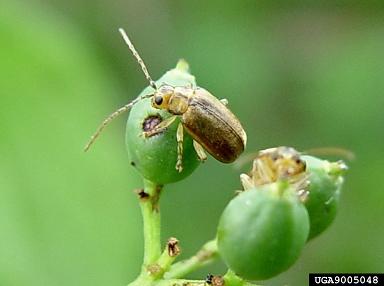
NOTE: this pest is not known to spread in or on firewood. It is included in the Gallery of Pests for general information purposes only.
- Viburnum leaf beetle was introduced to North America before 1947; the pathway has not been described.
- The viburnum leaf beetle is now established from the Atlantic coasts of southern Canada and New England to the Great Lakes; and in British Columbia.
- Several species of viburnums native to these regions have been heavily impacted by the beetle. It is unknown whether the beetle will kill viburnums growing elsewhere in North America.
The viburnum leaf beetle (Pyrrhalta viburni) was first detected in North America in the Niagara Peninsula area of Ontario, Canada in 1947 (Weston and Hoebeke 2003); well-established breeding populations were not documented until the 1970s (Weston and Hoebeke 2003). Not surprisingly, the first detection in the United States was in New York State in 1996 along the southern shore of Lake Ontario (Weston and Hoebeke 2003); it has subsequently spread to the east – along Lake Erie and the St. Lawrence Seaway and into northern Vermont; and west – e.g., Presque Isle State Park, Erie County, Pennsylvania and Conneaut, Ohio (Lake Erie lakefront near Pennsylvania border) (Weston and Hoebeke 2003). It is now widespread in New York State and Pennsylvania . (The eastern spread has also taken in the Ottawa/Hull areas of Ottawa and Quebec; the Canadian Maritime provinces; and Maine (Weston and Hoebeke 2003). By 2001, the viburnum leaf beetle had also been introduced to British Columbia – where it appears to be spreading rapidly southward toward the Washington State border (Murray). No information is available as to whether this West Coast population was introduced from eastern North America or directly from Europe.
In the East, the viburnum leaf beetle is most often found in low-lying areas near water – following the distribution of one of the preferred hosts, arrowwood (Viburnum dentatum var. lucidum) (Weston and Hoebeke 2003).
The viburnum leaf beetle is native to Europe (Weston and Hoebeke 2003). It feeds exclusively on many different species of viburnum. Highly susceptible hosts include the North American natives arrowwood (V. dentatum – many varieties); nannyberry (V. lentago); downy arrowwood (V. rafinesquianum); and American cranberrybush (V. trilobum) (Weston and Hoebeke 2003) and V. acerifolium(Lovett pers. comm. Feb 2010). The beetle also damages the introduced European cranberrybush (V. opulus) (Weston and Hoebeke 2003). Heavily attacked plants will have every leaf skeletonized by this pest (UMass Extension factsheet). Two or three consecutive years of defoliation can cause significant die-back of the canopy and kill a bush (Murray; Weston and Hoebeke 2003).
Viburnums have a wide geographic adaptation, versatility in the landscape, and visual beauty; there are approximately 150 species in the wild – mostly in Asia, Europe, and North America (Weston and Hoebeke 2003). Among the North American species susceptible to the beetle, the many varieties of arrowwood cover an immense range from New Brunswick across to Ohio, south to the mountains of northern Georgia. They are found in low, wet situations such as swampy woods (Weston and Hoebeke 2003). V. acerifoliumis a dominant understory plant in the Hudson Valley; (V. alnifolium) is dominant in the mountains of New Hampshire. Hobblebush is a key food source for moose and is the most important habitat plant for black-throated blue warblers (Lovett pers. comm. February 2008).
USFS scientists and managers developed a conservation priority-setting framework for forest tree species at risk from pest & pathogens and other threats. The Project CAPTURE (Conservation Assessment and Prioritization of Forest Trees Under Risk of Extirpation) uses FIA data and expert opinion to group tree species under threat by non-native pests into vulnerability classes and specify appropriate management and conservation strategies. The scientists prioritized 419 tree species native to the North American continent. The analysis identified 15 taxonomic groups requiring the most immediate conservation intervention because of the tree species’ exposure to an extrinsic threat, their sensitivity to the threat, and their ability to adapt to it. Each of these 15 most vulnerable species, and several additional species, should be the focus of both a comprehensive gene conservation program and a genetic resistance screening and development effort. Viburnum leaf beetle is not known to be a threat to any of these 15 most vulnerable species.
Sources
Barr, S.G. and G.A. Hoover. Pennsylvania State University Department of Entomology. Fact Sheet. September 2008.
Murray, T. Pest Alert! The Viburnum Leaf Beetle. No Date.
Potter, K.M., Escanferla, M.E., Jetton, R.M., Man, G., Crane, B.S., Prioritizing the conservation needs of US tree spp: Evaluating vulnerability to forest insect and disease threats, Global Ecology and Conservation (2019), doi: https://doi.org/10.1016/
Weston, P.A. and E.R. Hoebeke. 2003. Viburnum Leaf Beetle, Pyrrhalta viburni (Paykull) (Coleoptera: Chrysomelidae): Dispersal Patern of a Palearctic Landscape Pest in New York and its Distributiion Status in the Northeastern U.S. and Eastern Canada. Proc. Entomol. Soc. Wash. 105(4), 2003 (October 2003)



